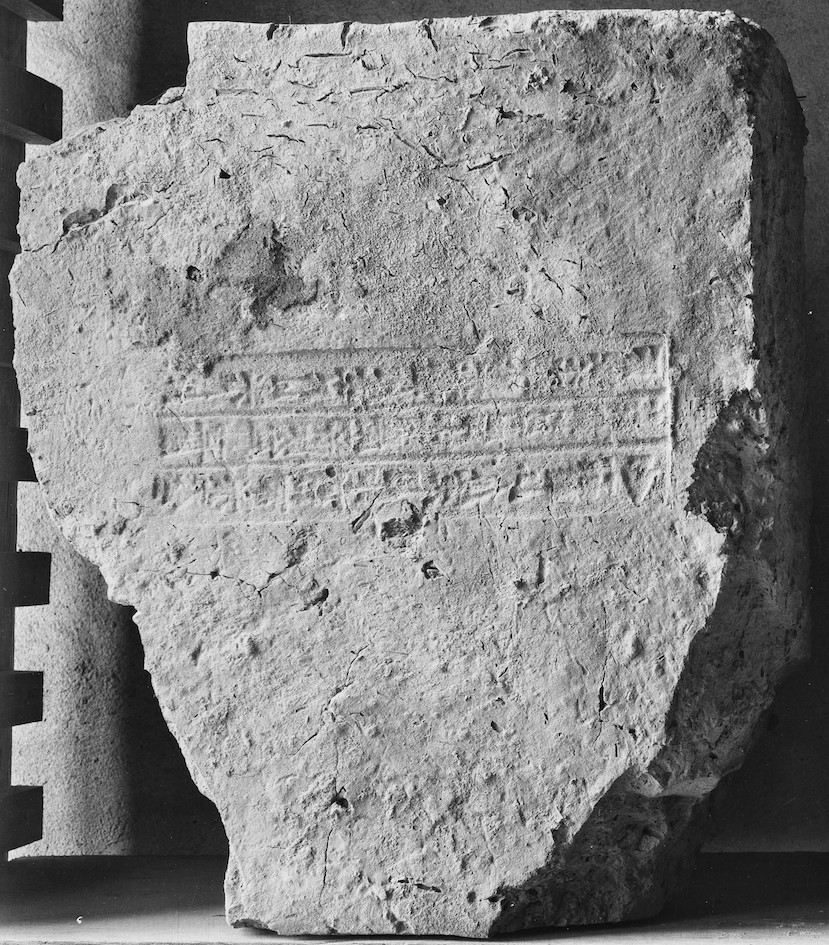Inscriptions of Amēl-Marduk
Jump to Amēl-Marduk 1 Amēl-Marduk 2 Amēl-Marduk 3 Amēl-Marduk 4 Amēl-Marduk 5 Amēl-Marduk 6
Few inscriptions of Amēl-Marduk are presently known. These are persevered on two bricks, a paving stone, and an alabaster vase discovered at Babylon, as well as three fragmentary vases unearthed at Susa. None of the six extant official texts of this son of Nebuchadnezzar II provide any real information about events of this Babylonian king's short reign. Although one text alludes to him having renovated the two most important temples in his kingdom — Esagil ("House Whose Top is High") at Babylon and Ezida ("True House") at Borsippa — there is no textual or archaeological proof that he actually undertook construction on either of these buildings. The near absence of inscriptions and descriptions of his accomplishments is not surprising since Amēl-Marduk ruled Babylon for less than three years.
Two bricks discovered during Koldewey's excavations at Babylon (western pillar of the Euphrates bridge) are stamped with a short, three-line inscription of Amēl-Marduk; the script is archaizing Neo-Babylonian. One of the king's titles in this text suggests that this son of Nebuchadnezzar II may have renovated Marduk's temple Esagil ("House whose Top Is High") at Babylon and Nabû's temple Ezida ("True House") at Borsippa. Because Nabopolassar, Nebuchadnezzar II, and Nabonidus all call themselves zānin Esagil u Ezida ("the one who provides for Esagil and Ezida"), that epithet might have simply been an honorary title in the case of Amēl-Marduk, rather than one that actually referred to him undertaking work on those two temples. This inscription is cited in previous literature as "Ewil-Merodach Brick A I, 1" or "[Amēl-Marduk] Brick Inscription (B1)."
Access Amēl-Marduk 01 [/ribo/babylon7/Q005380/].
Sources
| (1) BE 28999 [/ribo/sources/P518456/] | (2) Ist EŞEM 09176 [/ribo/sources/P518457/] (BE 42296) |
Commentary
The present whereabouts of ex. 1 (BE 28999) are unknown, but ex. 2 (BE 42296) is in the Eşki Şark Eserleri Müzesi (Istanbul). The master text and lineation follow ex. 1. No score of this short Amēl-Marduk text is given on Oracc since scores are not provided for texts on bricks (following the model of the RIM and RINAP series).

EŞ 9176 (BE 42296; Amēl-Marduk no. 1 ex. 2), a brick with a three-line proprietary inscription from Babylon.
Bibliography
Two paving stones found at Babylon bear a proprietary inscription of Amēl-Marduk in an archaizing Neo-Babylonian script. This text is sometimes referred to as "Ewil-Merodach Paving Stone I" or "[Amēl-Marduk] Paving Stone (PS1)" in earlier literature.
Access Amēl-Marduk 02 [/ribo/babylon7/Q005381/].
Sources
| (1) BE 03162 [/ribo/sources/P518460/] | (2) BE 20461 [/ribo/sources/P518485/] |
Commentary
The edition of the inscription presented here is based on the published excavation photograph in Koldewey, WEB5 (p. 160 fig. 99) since the original objects were not available, principally as the present whereabouts of the paving stones are unknown. Note that R. Koldewey (Ischtar-Tor p. 41) wrongly states that the excavation number of ex. 2 is BE 19274, which is joined to BE 20451 and which bears an inscription of an Assyrian king (probably Sennacherib). The correct number is BE 20461, which is photographed on Bab ph 1177.

BE 3162 (Amēl-Marduk no. 2 ex. 1), a paving stone with a two-line proprietary inscription found at Babylon.
Bibliography
Two fragments of an alabaster vase now in the Eşki Şark Eserleri Müzesi of the Arkeoloji Müzeleri (Istanbul) bear a proprietary inscription of Nebuchadnezzar II's son and immediate successor Amēl-Marduk. The text records that the vase had a capacity of one qa (ca. one liter). This inscription, which is written in contemporary Neo-Babylonian script, is referred to in previous studies and editions as "Ewil-Merodach Vase I, 1" or "[Amēl-Marduk] Babylon Vase (V1)."
Access Amēl-Marduk 03 [/ribo/babylon7/Q005382/].
Source
Commentary
Because the original could not be found in the Eşki Şark Eserleri Müzesi (Istanbul), as the collection number of the piece has never been published, the edition of the Babylon Vase in this volume is based on E. Nassouhi's copy (AfO 3 p. 66).
Bibliography
A fragment of a vase inscribed with a short text of Amēl-Marduk stating that the vessel once belonged to him was discovered in the ruins of the Elamite capital Susa; the script is contemporary Neo-Babylonian. The inscription records that the stone object had a capacity of one seah and six and a half akalu, which is about 6.64 liters. This text is cited in previous literature as "Ewil-Merodach Vase I, 2" or "[Amēl-Marduk] Susa Vase 1 (V2)."
Access Amēl-Marduk 04 [/ribo/babylon7/Q005383/].
Source
Commentary
The present whereabouts of Susa Vase 1 is unknown and, therefore, the edition of it in this volume is based on the partial copy and transliteration given by V. Scheil in MDP 5 (p. xxiii).
Bibliography
A second vase fragment from Susa preserves part of a proprietary inscription of the Babylonian king Amēl-Marduk. It records that the stone vessel's capacity was at least two qa (that is, about two liters). This text, which is written in contemporary Neo-Babylonian script, is referred to as "Ewil-Merodach Vase I, 3" or "[Amēl-Marduk] Susa Vase 2 (V3)" in earlier literature.
Access Amēl-Marduk 05 [/ribo/babylon7/Q005384/].
Source
Commentary
The present whereabouts of Susa Vase 2 is unknown. Like the previous text, the edition of this Amēl-Marduk inscription is based on V. Scheil's transliteration (MDP 10 p. 96).
Bibliography
A damaged vase with a short, proprietary inscription of Nebuchadnezzar II's son and successor was discovered during the French excavations at Susa. The text, which is written in contemporary Neo-Babylonian script, states that the alabaster vessel had a capacity of three and one-third akalu, which is approximately one-third of a liter. The inscription is cited in previous literature as "Ewil-Merodach Vase I, 4" or "[Amēl-Marduk] Susa Vase 3 (V4)." The edition given here is based on the published photograph.
Access Amēl-Marduk 06 [/ribo/babylon7/Q005385/]
Source
Bibliography
Frauke Weiershäuser & Jamie Novotny
Frauke Weiershäuser & Jamie Novotny, 'Inscriptions of Amēl-Marduk', RIBo, Babylon 7: The Inscriptions of the Neo-Babylonian Dynasty, The RIBo Project, a sub-project of MOCCI, 2025 [/ribo/babylon7/Rulers/Amel-Marduk/Inscriptions/]